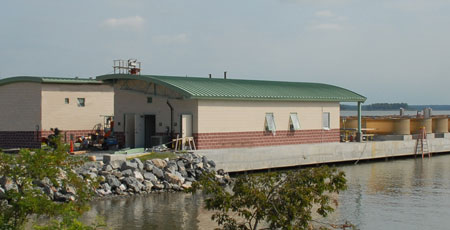Cambridge, Md. (August 15, 2010) – On the banks of the Choptank River, State, regional and University leaders dedicated a new $11 million Oyster Setting Facility at the University of Maryland Center for Environmental Science (UMCES) Horn Point Laboratory. Once fully operational, this new facility will more than double the laboratory’s annual production of oyster spat for Chesapeake Bay restoration, setting the stage for a significant expansion of the State’s aquaculture and environmental restoration programs.
 “By increasing the number of oysters available for sanctuaries, harvest reserve areas, public oyster grounds and our burgeoning aquaculture industry, this new facility will play a major role in our efforts to return the Chesapeake Bay’s oyster population to the vital ecological, economic and environmental resource it once was,” said Governor Martin O’Malley. “The State’s investment in this project demonstrates our long term commitment to that goal, and our faith that UMCES scientists will continue to expand and improve the science that makes large-scale restoration possible.”
“By increasing the number of oysters available for sanctuaries, harvest reserve areas, public oyster grounds and our burgeoning aquaculture industry, this new facility will play a major role in our efforts to return the Chesapeake Bay’s oyster population to the vital ecological, economic and environmental resource it once was,” said Governor Martin O’Malley. “The State’s investment in this project demonstrates our long term commitment to that goal, and our faith that UMCES scientists will continue to expand and improve the science that makes large-scale restoration possible.”
When fully operational, the new facility should allow the Horn Point Laboratory Shellfish Cultivation Program to produce up to two billion spat-on-shell for Chesapeake Bay restoration. In a decade’s time, scientific advancements and the adoption of new technologies have expanded annual production from 50 million to a record 750 million oyster spat in 2009. This new facility sets the stage for much greater advancements.
“This new facility is a reminder of Maryland’s long-term commitment to restoring the Chesapeake Bay and its oysters,” said UMCES President Dr. Donald F. Boesch. “The Center is grateful to state leaders including Governor O’Malley for securing the funds to make this unique facility a reality.
The new Oyster Setting Facility improves the efficiency of the oyster hatchery by allowing researchers to more easily “set” hatchery-reared larval oysters on oyster shells for transplanting in the Bay. By minimizing the number of times the spat on shell need to be handled, reducing pumping costs, and providing better quality water from the Choptank River to the tanks, production of seed oysters will improve and should result in more cost effective production.
“When combined with pioneering techniques that have increased the percentage of spat that successfully set, UMCES and its partners hope to bring oyster restoration efforts to the next level,” said Horn Point Laboratory Director Dr. Michael Roman. “By working with the Maryland Department of Natural Resources, the Oyster Recovery Partnership, Federal sponsors and others that share the goal of restoring healthy oyster populations to Chesapeake Bay, our work will lead to greater ecological and economic benefits to the State.”
Constructed by Cianbro Corporation under the direction of the Maryland Department of General Services, the pier measures approximately 300 feet long by 70 feet wide and utilizes reinforced concrete decking to hold fifty-two 12 feet diameter by 4.5 feet deep circular setting tanks. The mechanical area includes pumps capable of circulating 2,500 gallons of seawater per minute. This provides high quality water to support the growing oyster spat. A small wet lab allows scientists to monitor spat before they are deployed by vessels to restoration sites across Chesapeake Bay. The Shellfish Culture Facility at the Horn Point Laboratory contains the largest oyster hatchery on the East Coast and largest Eastern oyster (Crassostrea virginica) hatchery in the world.
“Our team members are proud to partner with UMCES and the Department of General Services to restore the bounty of the Chesapeake Bay,” said Cianbro Vice President and Regional Manager Mike Hart. “The construction team’s safety and productivity were exemplary, with zero recordable incidents during the duration of the project. This project created jobs for 73 direct hire Cianbro team members and 65 subcontractors. Despite the tough winter weather, the “can do” attitude of Cianbro’s team members and subcontractors delivered a world-class facility. We will all look forward to the “R” months with a renewed respect for the Chesapeake.”
The goals and objectives of the shellfish culture program at the Horn Point Laboratory have evolved over the years to meet the needs of the Center’s mission and the crisis with our troubled oyster populations. Early efforts aimed at identifying oyster culture techniques appropriate for use in the Mid-Atlantic region successfully demonstrated the possibility of using hatcheries for restoration. UMCES has used innovative approaches to incorporate its oyster culture program into its mission of research, education and outreach.
By incorporating the research and production capabilities into a coordinated program that follows the oysters from spat to adult, we can better develop guidelines that allow the State of Maryland and our partners to conduct not just oyster restoration but “smart restoration.” By incorporating the concept of smart restoration – and at the same time promoting active partnerships – UMCES is ushering into a new and exciting era of oyster restoration.
The University of Maryland Center for Environmental Science is the University System of Maryland’s environmental research institution. UMCES researchers are helping improve our scientific understanding of Maryland, the region and the world through five research centers – Chesapeake Biological Laboratory in Solomons, Appalachian Laboratory in Frostburg, Horn Point Laboratory in Cambridge, Institute of Marine and Environmental Technology in Baltimore, and the Maryland Sea Grant College in College Park.
# # #
Images from the Dedication:
# # #
Media Contact: David Nemazie, 443-496-0187

